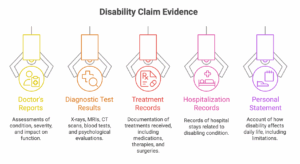Applying for disability benefits can feel overwhelming, but understanding the process and gathering the right medical documentation is key. This guide simplifies what you need to know to build a strong case.
Understanding Disability and Your Application
The Social Security Administration (SSA) defines disability as the inability to engage in any substantial gainful activity (SGA) due to a medically determinable physical or mental impairment that has lasted or is expected to last at least 12 months, or result in death. Your application hinges on proving this, with medical evidence being the cornerstone. Age, education, and work experience all play a part in the SSA’s determination. Younger applicants often face higher scrutiny since they are deemed more adaptable for retraining. Conversely, older applicants with limited education and extensive work history in physically demanding jobs may have an easier time qualifying, if their impairment prevents them from continuing similar work.
Gathering Essential Medical Evidence for Your Disability Claim
Start by compiling a comprehensive list of all your medical providers. This includes doctors, specialists, therapists, and hospitals you’ve consulted. Obtain complete medical records from each source. Don’t just assume the SSA will get them for you; proactive gathering strengthens your claim.
Building a Strong Medical Case: Types of Evidence Needed
Strong medical evidence paints a clear picture of your limitations. This includes:
- Doctor’s Reports: Detailed assessments of your condition, its severity, and its impact on your ability to function.
- Diagnostic Test Results: Think X-rays, MRIs, CT scans, blood tests, and psychological evaluations. For example, an MRI showing severe spinal stenosis can be powerful evidence for a disability claim based on back pain. Another potent piece of evidence could be a neuropsychological evaluation demonstrating cognitive deficits for a claim related to a traumatic brain injury.
- Treatment Records: Documentation of all treatments received, including medications, therapies, and surgeries, along with their effectiveness (or lack thereof).
- Hospitalization Records: Records of any hospital stays related to your disabling condition.
- Personal Statement: A detailed account of how your disability affects your daily life, including specific limitations in activities like walking, sitting, lifting, and concentrating. This is your chance to humanize your application.

Effectively Presenting Your Medical Evidence in the Disability Application
Organize your medical evidence chronologically and by provider. Clearly label each document. Include a cover letter summarizing your disability and highlighting the key medical evidence that supports your claim. Focus on how your condition prevents you from performing work-related activities.
What to Expect After Submitting Your Disability Application: Medical Review
The SSA will review your application, often sending it to Disability Determination Services (DDS) in your state. DDS will assess your medical evidence and may request additional information or a consultative examination (CE) with an SSA-approved doctor. Cooperate fully with these requests.
Common Mistakes in Providing Medical Evidence and How to Avoid Them
A common mistake is submitting incomplete medical records. Make sure you provide everything relevant. Another is failing to clearly explain how your condition limits your activities. Be specific in your personal statement.
Appeals and Additional Medical Evidence in Your Disability Case
If your application is denied, don’t give up. You have the right to appeal. During the appeals process, gather new or updated medical evidence, address the reasons for the initial denial, and consider seeking help from a disability attorney or advocate. Vocational rehabilitation programs can also provide support and assessment services, which may further strengthen your case. They can evaluate your ability to return to work and suggest necessary accommodations or training, providing additional evidence of your limitations.




